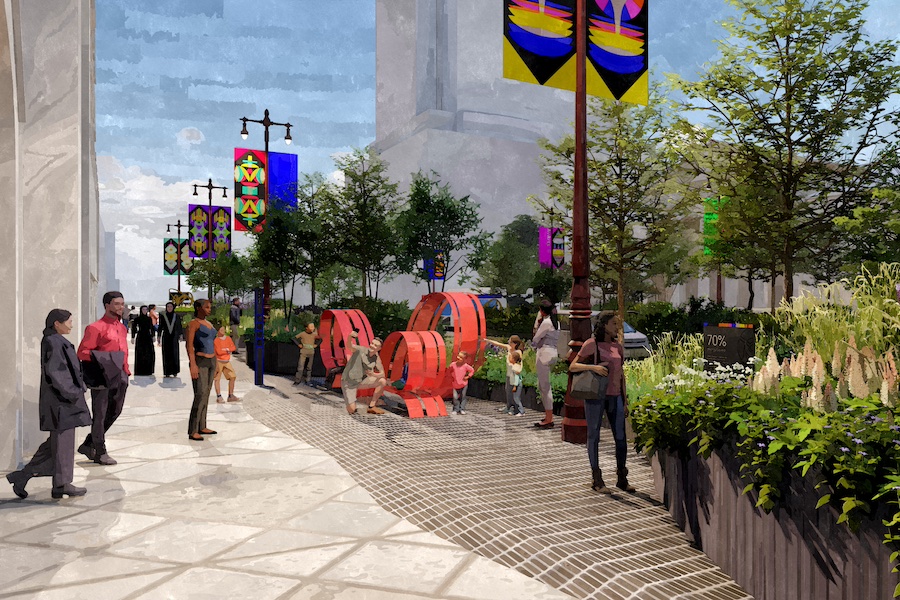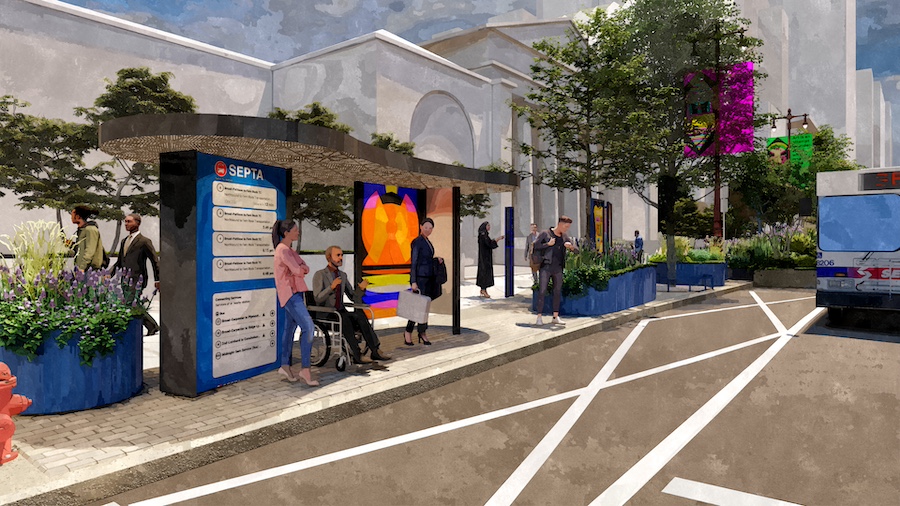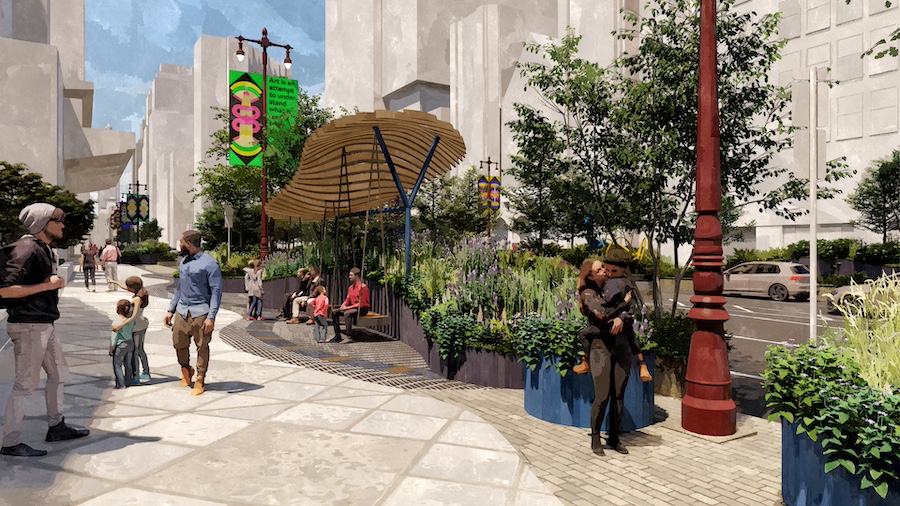Plans Revealed to Turn the Avenue of the Arts Into a 10-Block Park
Starting with a demonstration project in the 300 block, the plan will bring greenery, outdoor seating and environmental benefits to South Broad Street.

Rendering of the reimagined 300 block of South Broad Street, the initial phase of the Avenue of the Arts 2.0 project. / Renderings by OJB Landscape Architecture via Avenue of the Arts Inc.
At a news conference at the Kimmel Center this morning, Avenue of the Arts and city officials took the wraps off a $100 million project that aims to transform South Broad Street into a 10-block-long arts park stretching from City Hall to Washington Avenue.
Called Avenue of the Arts 2.0, the project will produce a park with lush landscaping, cafe seating and green medians studded with public art. Aerial sculptures, public art and outdoor performance spaces will line the sidewalks. And enhanced lighting will make the street a day and night destination. Avenue of the Arts Inc. has selected architecture, planning and design firm Gensler and OJB Landscape Architecture to produce the new streetscape.
The firms will also work with civil engineering firm Langan and lighting design firm LightBox Studios on the project.

The design calls for public art throughout the initial block, including the kind people can sit on.
Speakers at this morning’s event cited the rich history and cultural legacy of South Broad Street and the institutions that line it as one of the reasons to launch this second makeover. “Steps from here are iconic historic theaters like the Miller, with its impressive new marquee, and the Academy of Music, the oldest operating opera house in the country, where legends have performed,” said Avenue of the Arts Inc.’s executive director Laura Burkhardt. She then rattled off the other notable arts organizations with theaters on the street, including the Philadelphia Theatre Company in the Suzanne Roberts Theatre and the Tony Award-winning Wilma Theater.
Burkhardt also highlighted the size of the cultural district and its impact on the local economy. “We have 10,000 performing arts seats” in the theaters along the avenue, “second only to New York City’s Broadway. And we host more theater, music, dance and film events annually than all the home games of all of our professional sports teams.”
The first South Broad Street improvement project, which created the Avenue of the Arts in 1993, cost $378.4 million. According to Avenue of the Arts Inc., the remake generated $157 million in economic activity annually, recouping the investment in 2.5 years.

New wayfinding systems and artistically designed bus shelters will also be incorporated into the initial phase.
Now, Avenue of the Arts will need to raise the $100 million total project cost through fundraising from foundations and individuals. Tiphanie White, chief of staff in City Council President Kenyatta Johnson’s Second Council District office, announced at this morning’s news conference that the City of Philadelphia would get the campaign rolling with a contribution of $1 million to the fund from this year’s budget.
The project will be executed incrementally, one block at a time. The proof-of-concept block will be the 300 block of South Broad Street, from Spruce to Pine. This block includes the Kimmel Center and the building designed by architect John Haviland in 1824 for the Pennsylvania Institute for the Deaf and Dumb (now the Pennsylvania School for the Deaf), most recently Dorrance Hamilton Hall at the shuttered University of the Arts.
Groundbreaking will take place in early 2025. The block should be completed in the spring of 2026, in time for the FIFA World Cup matches, the MLB All-Star Game and the celebration of America’s 250th birthday.
In a conversation after the news conference, developer and Avenue of the Arts board member Carl Dranoff explained that several years of talks involving Avenue of the Arts, SEPTA and PennDOT, plus clever design work on Gensler’s part, have made this pilot project possible.

By turning sidewalk subway air vents into ducts, the designers at Gensler can add larger, more substantial planting islands to the block along with more varied seating.
The design will also have environmental benefits beyond the shade the trees will provide. The substantial berms filled with plants will absorb rainwater, reducing runoff. And the tree-studded median will also solve a problem SEPTA has wanted to fix for some time: namely, water leaking into the subway tunnel beneath the block. The green median will act as a sponge placed over the subway.
Oliver Schaper, the designer in charge of the project at Gensler, explained at the news conference that the designers would apply lessons they learn as they build this first block to the later blocks in the project.
When asked why the organization chose this time to launch the project, Dranoff explained, “We are a post-pandemic city, and we want to change our thinking from cars to pedestrians. People want to eat outside. They want a park-like setting. They want clean air and greenery. And all these things are crucial for the city to prosper in the future.
“We are going to be a prototype for the rest of North America because we are on the cutting edge” of streetscape design with this project, he continued.
Avenue of the Arts Inc. Board Chair Dianne Semingson echoed Dranoff. “It’s been 31 years since this street was paid attention to, and it needs to be polished,” she said. “And we need more color, and it needs to be environmentally sound.
“I remember that when I was working for the city, I said that Philadelphia is in a perpetual state of potential. This street has the potential to be one of the greatest in the country. And that’s what we’re working on together.”
Updated July 9th, 5:03 p.m., to correct the spelling of the names of three people identified in this article: Tiphanie White, Oliver Schaper and Dianne Semingson. Updated July 10th, 12:09 p.m., to clarify Tiphanie White’s position. Updated August 13th, 11:47 a.m., to correct the name of the lighting designer.


